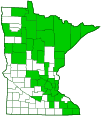Strict-branched Coral Fungus
(Ramaria stricta)
Conservation • Description • Habitat • Ecology • Distribution • Taxonomy
|
|
||||||||||||||
Description |
Strict-branched Coral Fungus, also called Upright Coral Fungus, is a common, widespread, medium sized, coral fungus. It occurs in Europe, Asia, North America, and Central America, and there are scattered records of it throughout the southern Hemisphere. In the United States, it occurs east of the Great Plains and on the West Coast from northern Washington to central California. It is common in Minnesota. Strict-branched Coral Fungus is found alone, scattered, or in groups but not clustered (gregarious), in woodlands, from July through October. Unlike most coral fungi, it grows on dead stumps, trunks, and branches of both deciduous and coniferous trees. It sometimes appears to be growing on the ground, occasionally in lines, when it is actually attached to buried logs or branches. It gets its nutrients from dead wood (saprobic). The fruiting body is densely branched, 1½″ to 5½″ (4 to 14 cm) high, and 1½″ to 4″ (4 to 10 cm) wide. It grows from a whitish, slender, stalk-like base (stipe). The stipe can be anywhere from well-developed to rudimentary, almost absent. It is attached to the substrate (wood) by numerous white, root-like cords (rhizomorphs). The branches are upright and nearly parallel. They are sometimes grooved, often flattened, usually compact, sometimes open and bushy. They are pale yellow at first, becoming pinkish brown, orangish, tawny buff, or light brown as they age. They stain brown or purplish brown when bruised. The branch tips are yellow or pale yellow when young. When growing on conifers, the fruiting body tends to be bushy and yellowish. When growing on hardwoods, it tends to be more orange. The flesh is tough, insubstantial, and unpleasantly flavored, often bitter. It is considered inedible. The spore print is cinnamon buff to dark yellow. |
Similar Species |
Habitat and Hosts |
|
Ecology |
Season |
July through October |
Distribution |
||
|
Sources |
|
| 7/12/2024 | ||
Occurrence |
||
Common |
||
Taxonomy |
|
Kingdom |
Fungi (Fungi) |
Subkingdom |
Dikarya |
Phylum |
Basidiomycota (Basidiomycete Fungi) |
Subphylum |
Agaricomycotina (Higher Basidiomycetes) |
Class |
Agaricomycetes (Mushrooms, Bracket Fungi, Puffballs, and Allies) |
Subclass |
Phallomycetidae |
Order |
Gomphales |
Family |
Gomphaceae |
Genus |
Ramaria (coral fungi) |
Subgenus |
Lentoramaria |
Subordinate Taxa |
|
Ramaria stricta var. concoloris sometimes treated as the full species Ramaria concolor. Some sources do not recognize any varieties of Ramaria stricta. |
|
Ramaria stricta var. alba Ramaria stricta var. concolor Ramaria stricta var. condensata Ramaria stricta var. laxiramosa Ramaria stricta var. stricta Ramaria stricta var. violaceotincta |
|
Synonyms |
|
Clavaria condensata Clavaria kewensis Clavaria pruinella Clavaria stricta Clavaria syringarum Clavariella condensata Clavariella stricta Corallium stricta Lachnocladium odoratum Merisma strictum Ramaria condensata |
|
Common Names |
|
Straight Branched Coral Straight-branched Coral Straight-branched Coral Mushroom Strict Coral Mushroom Strict-branched Coral Fungus Upright Coral Upright Coral Fungus |
|
Glossary
Rhizomorph
A root-like, mycelial cord of a fungus, formed from vessel hyphae surrounding sheathing hyphae, and capable of transferring nutrients over long distances.
Saprobic
A term often used for saprotrophic fungi. Referring to fungi that obtain their nutrients from decayed organic matter.
Stipe
A supporting stalk-like structure lacking vascular tissue. In fungi, the stalk supporting the mushroom cap. In ferns, the stalk connecting the blade to the rhizome. In flowering plants, the stalk connecting the flower’s ovary to the receptacle. Iin orchids; the band connecting the pollina with the viscidium.
Visitor Photos |
||
Share your photo of this fungus. |
||
This button not working for you? |
||
Paul |
||
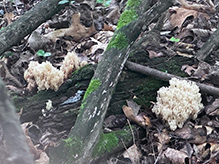 |
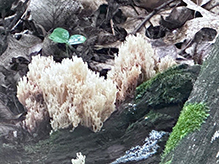 |
|
 |
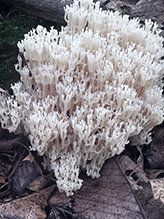 |
|
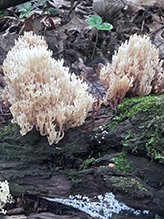 |
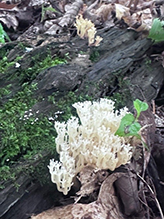 |
|
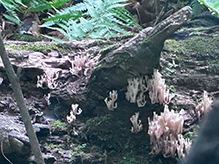 |
 |
|
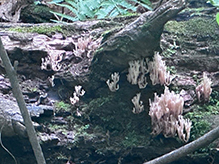 |
|
|
Alfredo Colon |
||
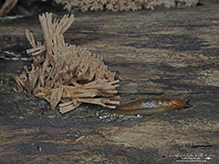 |
|
|
MinnesotaSeasons.com Photos |
||
|
||
|
||

Visitor Videos |
||
Share your video of this fungus. |
||
This button not working for you? |
||
|
Other Videos |
||
Ramaria stricta, commonly known as the strict-branch coral is a coral fungus of the genus Ramaria. |
About
Jun 1, 2019 I go through the forests, mountains, hills, fields, and waters to understand the living world and to create a living mind. Ramaria stricta, commonly known as the strict-branch coral is a coral fungus of the genus Ramaria.It has a cosmopolitan distribution, and grows on dead wood, stumps, trunks, and branches of both deciduous and coniferous trees.The fungus is inedible due to its unpleasant odor and bitter taste. |
Coral Fungi (Ramaria stricta) |
About
Aug 19, 2009 Photographed at the Rydell NWR, Minnesota (18 August 2009). Go here to learn more about this species: https://www.mushroomexpert.com/ramaria_stricta.html |
Upright coral fungus (Ramaria stricta) - November 2022 |
About
Nov 29, 2022 https://en.wikipedia.org/wiki/Ramaria_stricta |

|
Created: 7/12/2024 Last Updated: © MinnesotaSeasons.com. All rights reserved. |
